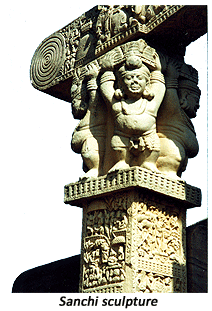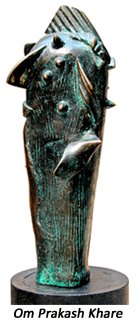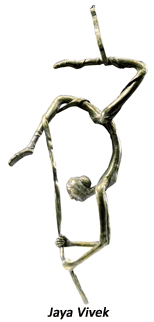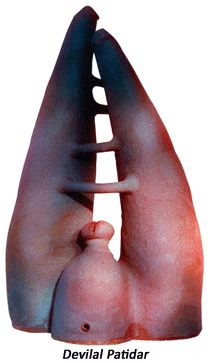- Prelude
- Editorial
- 'Public Sculptures are the Public's own Consciousness'
- Stimulating Thoughts
- Sculptural Traditions and Contemporary Art Practices
- Sculpting out a Third Dimension from Madhya Pradesh
- About Nostalgic Dragonflies and Homes in the Bags: Sculptural Snapshots from the North-East
- A Concise Chronicle of Bengal's Modern Sculpture
- Neo-sculptural Identity: Six Young Sculptors
- From Object to Experience: Notes on American Sculpture
- In the Domain of Drama Sculptures of S.Nandagopal
- Satish Gujral : Sculpting the Inner Form
- Transformation of Articulations: Mrinalini Mukherjee
- The Experiential Quotient in the Sculptures of Ravinder Reddy
- Shresta Rit Premnath A Passion for Structure
- The Anatomy of Melancholy: Sculptures of Rajesh P Subramanium
- A Crusader of/for Site Specific Public Art: Subodh Kerkar
- Installation Practices in and around Santiniketan
- A Wall is a Screen: A Promenade Film Street Performance
- Jaeger-LeCoultre An Overview
- Regency Style: Regency Furniture
- Designing the Streetscapes: Visual Elements of Pedestrian Corridors
- Sculpture Rules It All
- The Triumph of the Eternal
- Artist Index and Statistics- Anish Kapoor
- Auction Reports
- Musings from Chennai
- Art Bengaluru
- Art Events Kolkata: October-November 2010
- Mumbai Art Sighting
- An Evening of Interaction
- 6th Asian Museum Curators' Conference
- Swedish Art in India
- Couple of Difference : Recent sculptures of Karl Antao
- Previews
- In the News
- Sotheby's : Important Watches Geneva
ART news & views
Sculpting out a Third Dimension from Madhya Pradesh
Volume: 3 Issue No: 11 Month: 12 Year: 2010
by Saba Gulraiz
The history of sculpture in Madhya Pradesh is as old as our civilization. The tradition harks back to the splendid sculptures of the pre-historic and historic sites. The temples of Khajuraho and Stupas of Sanchi are its clear evidences.  The élan of magnificent sculptures of Khajuraho temples still exemplifies the exuberance of their executors. The erotic sculptures built during 900 AD to 1000 AD by Chandela rulers, depict varying human relations and expressions, arousing both visual and sensual delights, whereas the majestic sculptures of Gautam Buddha at Sanchi feature his meditative state, evoking a sense of spiritual peace. These intricately carved sculptures portray the scenes from the life of Buddha and Jatakas; the stories are related to the Buddha and his earlier births. The magnificent stupas, monasteries, and monumental pillars built by the Maurayan emperor, Ashoka around 1st century AD, bear the clear impression and style of Mathura and Gandhara schools of sculptures. These sculptures embody an intertwined relation of art with faith and religion. Like any other ancient historical monuments, these have become the sites for religious and cultural discourses mapping out the cognitive contours of elapsed times. Be those the Khajuraho temples or the Stupas of Sanchi, or any other historical sites for that matter, those sculptures have virtually become the religious and cultural repositories of India's otherwise ambiguous past.
The élan of magnificent sculptures of Khajuraho temples still exemplifies the exuberance of their executors. The erotic sculptures built during 900 AD to 1000 AD by Chandela rulers, depict varying human relations and expressions, arousing both visual and sensual delights, whereas the majestic sculptures of Gautam Buddha at Sanchi feature his meditative state, evoking a sense of spiritual peace. These intricately carved sculptures portray the scenes from the life of Buddha and Jatakas; the stories are related to the Buddha and his earlier births. The magnificent stupas, monasteries, and monumental pillars built by the Maurayan emperor, Ashoka around 1st century AD, bear the clear impression and style of Mathura and Gandhara schools of sculptures. These sculptures embody an intertwined relation of art with faith and religion. Like any other ancient historical monuments, these have become the sites for religious and cultural discourses mapping out the cognitive contours of elapsed times. Be those the Khajuraho temples or the Stupas of Sanchi, or any other historical sites for that matter, those sculptures have virtually become the religious and cultural repositories of India's otherwise ambiguous past.
Drawing inspiration from the wealth of sculpted artistry of this ancient past, the artistic journey of sculpting was constantly evolving. This was the time when art of sculpture came out of the temples to embellish the royal palaces, parks and other public places.  Royalty had always had a great fascination for art, especially for sculpture; to not only add to the beauty of their luxurious palaces but to speak of their glorious victories.
Royalty had always had a great fascination for art, especially for sculpture; to not only add to the beauty of their luxurious palaces but to speak of their glorious victories.
Gradually, the purpose of art saw a transfiguration from the numinous to the transcribing of the glory of royal patrons. Madhya Pradesh also witnessed the same change, especially in the art of sculpture. During the early 20th century Raghunath Phadke, a famous portrait sculptor of his times, was invited by the Maharaja of Dhar who asked him to be his courtier. Phadke was born in 1884 at Vasai, Maharashtra and had his studio at the same place, but having been invited, he decided to move to Dhar in Madhya Pradesh, where he was allotted a plot of land to start his studio. Phadke's studio flourished under the royal patronage, but after his death in the year 1972, it came to be neglected due to the apathetic attitude of the government and lack of funds. Now it is almost in a dilapidated state, waiting for a new lease of life. Phadke's contribution should be recognized not only as a master sculptor but also as a pioneer in providing the much-needed training to the new generation sculptors.
Like Phadke, Rudra Hanji, who, though not born in Madhya Pradesh, belonged to this place heart and soul. He was born in 1911 at Tarikere Karnataka, moved to Shantiniketan to receive training in sculpture from the master sculptor Ramkinkar Baij. Upon the invitation sent by Vijay Rajya Sindhiya, he shifted to Gwalior. He did not leave the place in his life time because of his sheer dedication to his job as a teacher in Padma girl's school, and for his deep attachment to the cultural milieu of Gwalior. The aspect of discipline and modesty of his own persona is quite visible in his sculptures. His sculptures of Saraswati, Natraj, Gautam Buddha, can be seen at various places in Gwalior like the precincts of Padma School, Kala Vithika and other public places. In these statues one might not find modern experimental idioms, but the classical grace he imparted to them is astonishing. In this sense he revived the classical Indian expressions.  Rudra Hanji will always be remembered for his determination to bring out the art of sculpture from the royal courts into the academic institutions and within the reach of the common man.
Rudra Hanji will always be remembered for his determination to bring out the art of sculpture from the royal courts into the academic institutions and within the reach of the common man.
As art was slowly extricating itself from the closed world of temples and palaces, coming into an open space, interest of the artist was also shifting from the purely formal approach to the expressions of his personal experiences. Now he could afford to free himself from the dictates of his patrons that had curbed his individual artistic emotions. He had now come to collaborate with the natural surroundings to draw inspiration from, but at the same time he realigned his own identity with the artistic legacy of his historical past. This dual vision, one grounded in the past, other in his immediate cultural and social milieu, helped him explore his own space in the contemporary world.
Madan Bhatnagar was the name among such artists who were exploring this new space in the sculptural art. Born in 1931 at Gwalior, he went to Shantiniketan to receive training from Ramkinkar Baij who was a trail blazer in quickening the modernist movement in Indian sculpture. In order to imbibe the spirit of modernism, Madan Bhatnagar veered towards abstraction. He has always been known for his experiments into various mediums and material. Being a teacher, his experiments were always for the benefits of his pupils. He was the driving force behind the opening of sculpture department in Government College of Fine Arts in Gwalior. Whether it was the organization of camps or any other art activities, he had always shown his enthusiasm while working with his students. Perhaps this was the reason why a big group of young sculptors emerged from Gwalior only. Among them there are names like Robin David, Jaya Vivek, Anil Kumar, Om Prakash Khare and Shashikant Mundi. They have now come up as the prominent sculptors of India.
Robin David carves out his own path from the hard stony ways of life, and never allows his spirit fade away in the midst of adversities. In his eventful life, initially there were many curves that finally shaped his destiny as a sculptor.  This happened in 1979, when one day after resigning from his post in Kala Parishad, he, just like a disillusioned filmy hero, started off from Gwalior on his two-wheeler and stopped only when he reached Bhopal. He joined the newly born Bharat Bhawan as an Assistant Director, but later, by some quirks of fate, landed in the marble world of Makarana (Rajasthan). His passion for Makarana marble is not new. It was growing with him since his childhood when he would bunk his school and would go to watch stone carvers making idols along the road side. He never had any liking for the mundane methods of academic teaching in his school and college. He would rather simply love to hang out with the sculptures of Gwalior fort to learn from them his lessons of sculpting.
This happened in 1979, when one day after resigning from his post in Kala Parishad, he, just like a disillusioned filmy hero, started off from Gwalior on his two-wheeler and stopped only when he reached Bhopal. He joined the newly born Bharat Bhawan as an Assistant Director, but later, by some quirks of fate, landed in the marble world of Makarana (Rajasthan). His passion for Makarana marble is not new. It was growing with him since his childhood when he would bunk his school and would go to watch stone carvers making idols along the road side. He never had any liking for the mundane methods of academic teaching in his school and college. He would rather simply love to hang out with the sculptures of Gwalior fort to learn from them his lessons of sculpting.
His preference for Makarana marble is his conscious choice, as it has the extraordinary qualities of brilliant lustre, whiteness that does not fade away with time. So his understanding of the qualities of his material and his knowledge of the technique helped him explore new dimensions in his sculpture. While chiseling out marble to create a particular form, he takes care so that it retains its original characteristics. His sculptures titled 'Together' maintains stone's real quality beautifully, where there is a black sculpture with white veins and a white sculpture with black veins. He never deliberately tries to lay bare the hidden characteristics of his material by chiseling it out in one go, and does not disregard the claims of the outer appearances of the stone. His hand patiently moves on while he chisels out the extra mass to create his abstract form, where rhythm and movement have always been the primary concerns of the artist.
For him lines are the most important elements of any sculptural form, as it is inevitable in presenting a particular expression, else a slight ill-judgement in curving lines damages the whole expression. So it is always a matter of right judgement. In Robin's works one can see this perfect match between his perception and technical skill. Work is executed with a keen eye and focused hand. In this process spontaneity is never compromised.
Another significant sculptor from Madhya Pradesh who finds in marble a great potential to translate his artistic aspirations is Anil Kumar. Robin David and Ramesh Pateria's passion for marble took them to Makarana, while Anil Kumar didn't have look too far for his material. Being Born and placed in Gwalior, Gohra marble was easily accessible to him. The unique quality of this marble that attracts Anil is its natural grey, green and black colour. Initially Anil carved out his animal kingdom in this marble, the turtle being long the most favourite motif of the artist. Other creatures that are metamorphosed by him are fish, frog, and rhino. What might have attracted him about these otherwise slimy creatures, are their rough and hard stone-like bodies and the delicate beings inside. His rounded and sleek forms are the projections of this feeling. He is disinclined to reveal any elaborate details in his forms. Absence of details renders his basic forms rather abstract. He does not attempt to put forth any dominant scheme of thought, and believes that it is precarious to relate a new experience with the past stories. He simply seeks to explore the real diversity in the natural world of fauna along with their dynamics. His concern is to transform mass into an illusion of motion. His stone quivers with life at the slightest touch. The dimensions in their postures and positions are such that forms do not remain petrified, they are eager to take a leap.
His stone quivers with life at the slightest touch. The dimensions in their postures and positions are such that forms do not remain petrified, they are eager to take a leap.
He yokes together many binaries in his single pieces--organic and inorganic, smoothness and roughness, motion and stillness. His sophisticatedly polished smooth forms lull us into an erotic dreamland. Anil has literally left no stone unturned. He has tried his hand in every stone available to him ranging from Gohra to Makarana to Basalana. Recently he is working in granite as it offers him a wide range of colour to enliven his faunal world.
Chandrasen Jadhav moves into an entirely new dimension. He moves away from the traditional style of sculpting where artists are preoccupied in etching out even the minutest details. He is unmindful of such detailing. What he tries to capture are the various moods, not the beauty frozen in marble. His sculptures are alive with poignant emotions. The magic of his hands transforms stone into glass. This transparency is a unique part of his art. The glimmering white gives an illusion of faces being strewn with a transparent cloth, concealing sculpted features, and distilling human moods.
In today's India when many artists in their enthusiasm have been carried away by the current of globalization, Om Prakash Khare goes back to his roots. He seeks inspiration for his art from the Indian tribal world where art of sculpture is firmly anchored in their rituals and traditions, in their practice of raising memorial pillars, in their carving of images of their deities. All these have a clear bearing on his creativity. Khare believes creativity is the cumulative effect of our society, religion and nature. His preoccupation with the images of Gram Devta (village deity) springs out from this belief. His inspiration comes from his close association with the amorphous stone images resurrected under the shade of Peepal and Banyan trees which are common sights in Indian villages. These images always give him a sense of some supernatural presence. His images assume strange and awful shapes that evoke a feeling at once pious and fearsome.
Born in Gwalior, this unconventional sculptor is known for both his individualistic manner of sculpting, and his quality of draughtsman ship. Whether it is his theme or the use of varying material or colour, he has carved out his unique individual place as a sculptor. His sculptures are endowed with the quality of simplicity. His forms evolve naturally; these are always in the process of taking shapes. He makes no efforts to make his forms congruous. They seem to take their own shapes out of deformities. These deformities sometimes instill in us a strange feeling. Most of his sculptures are done in terracotta and wood to give a tribal feel, but in his recent series of 'Human figures' and 'Nature' done in stone, he creates highly polished surfaces in contrast with textures.
Metal has always been used as a medium of expression even from the primeval days. Its ductile and malleable nature offers an artist a good number of possibilities in terms of flexibility in casting forth his artistic expressions. Though metal is extensively used today,  women sculptors seem to be a trifle reluctant to accept this medium, mostly because of the common notion that this is not a woman's domain, as it demands a great deal of physical strength. Jaya Vivek dispels this notion by not only accepting this medium as a challenge but using it with consummate ease in the realization of her aesthetic sensibilities.
women sculptors seem to be a trifle reluctant to accept this medium, mostly because of the common notion that this is not a woman's domain, as it demands a great deal of physical strength. Jaya Vivek dispels this notion by not only accepting this medium as a challenge but using it with consummate ease in the realization of her aesthetic sensibilities.
Born in Gwalior, Jaya comes from a family of painters but she always found painting to be too constricting in its two-dimensional space for self-expression. After getting a diploma in sculpture from Gwalior Art College, like many of her artist friends she moved to Bhopal to become a comrade in J. Swaminathan's haunt for collecting tribal artefacts from various parts of Madhya Pradesh, and since then she has been living and working here with her husband who is also an artist.
Traveling down the lanes of memories of her juvenile days, Jaya creates a play field where boys and girls in their carefree moments are performing their acrobatic feats. In their impassioned enjoyment, they throw up their body weight in air playing gullidanda, flying kites, rolling wheels. Jaya is not weaving dreams; she is letting them loose from the gravity to float in a fluid space. She casts her dreams with great care and skill, where forms are reduced into lines. Her figures in their postures and expressions have a rare grace. In their action sequences she creates a dynamic equilibrium, a momentary balance that makes the viewer standstill, and the placard reads, “Stop here or gently pass.”
In today's contemporary sculptural practices where marble and metal have emerged as strong mediums of expression in terms of their durability and natural lustre, Devilal Patidar makes a deliberate choice of using clay as his medium, as in clay he finds a greater freedom of expression than in any other medium. The responsive nature of clay offers him a great degree of flexibility in modeling his sculptures into desired shapes.
Born at village Sundrel in the Dhar district of Madhya Pradesh, Patidar initially took up painting as a vocation after graduating in fine arts from Indore in 1984. Getting an assignment of designing a book written by J. Swaminathan, he came to Bhopal, and later joined Bharat Bhawan as the Deputy Director of the ceramic workshop there. This is the apparent reason behind his switch-over to sculpture from painting. Both in his paintings and sculptures, Devilal uses a tactile vocabulary of erotic nature. He explores a possible aesthetic space in the physical proximity of mutually generative forces--male and female. The key images that consistently emerge in his art are the male and female genitalia manifested in the simple self-assertive utility objects of rural India. It will be an over-simplification to interpret his works as the representation of erotic desires. There is a deeper symbolic significance where he sifts through the Indian mythological heritage to contemporanize the myth of Ardhnarishwar, the Lord of creation. In this manifestation, the right half of the icon is male at its most virile, while the left half is female at its most bewitching feminine.
His 'Lantern' series explores the same myth of Ardhnarishwar. He uses lantern as the symbol of man's intense desire to unite in the physical act of sex. The subject itself is very challenging as there is always a thin line between the aesthetic and the obscene. Patidar is candidly vocal when he talks about this aspect of his art, saying that he had to spend seven complete years in studying the various aspects of sex. For him it was difficult to overcome this obsession. “Every thing seemed to have turned into a phallic imagery. There was no difference between a finger and a penis.” He confesses that his initial works had a tinge of this vulgarity.
There was no difference between a finger and a penis.” He confesses that his initial works had a tinge of this vulgarity.
Images of genitalia keep informing his works in one or the other inanimate objects. “I am obsessed by a central concept”, says Patidar. But his obsession sometimes makes a departure from his central theme to other concerns of human life. His series of 'Time' delves deep into the ever-recurring universal phenomenon of destruction; the very nature of human race. This context is represented by him in the form of a table clock that records all the destructive times. He also finds a great fascination for aquatic plants and animals. What attracts him are their delicate and fragile streamlined forms and the rhythm they create while moving in water with quick agility. To create this illusion is not easy in a sold medium like his. He does a lot of experiments in his technique to achieve the illusion of delicacy and rhythm.
To understand Devilal's art one does not need any minimum qualification, as his expressions deal with very intimate human desires, dreams and concerns; capable of direct communication without barriers. However some might put in a larger question of ethics.
If we talk of sculptural art in totality, we will notice that it has suffered from some limitations that put a restraint on both its expression and process. Dominant use of traditional modes and material sometimes makes the work process strenuous and limits the possibilities of refinement. I do not mean that our contemporary sculptors are not receptive to modern techniques and tools, but like our contemporary painters, who have already ventured forth in the modern vistas, they need to overcome their reluctance to embrace innovative methods to create new possibilities in their art. There are still other constraints that limit the possibilities of widening the space of sculpture in Madhya Pradesh. Today sculptors confront the problems of feasibility, neither galleries nor their houses or workshops, if they have any, are feasible enough to properly preserve the fragile nature of sculptures. The other big question can be raised on the role of institutions. They are neither well-equipped nor do they have any earnest desire to provide proper training in sculpture. Under these conditions, if young artists ever endeavour to invest their faith and energy in sculptural art, they deserve our accolade.